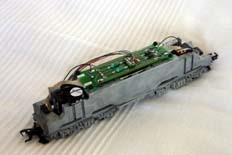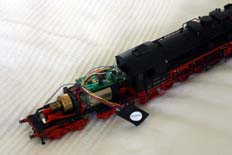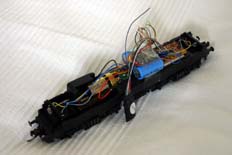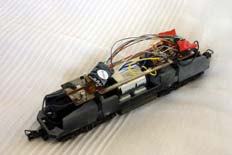Back to Contents
Back to DCC
Link to Sitemap
ESU LokPilot v3.0

Well, here we go with another review. This time it's thanks to ESU's official UK importers, South West Digital who kindly provided me with the review sample after talking to Steve and Caroline and ordering a LokSound decoder for a project at the Telford 0-gauge show in 2006. Owing to number of unforeseen things the decoder then sat on a shelf for quite a while before I got round to giving it a test, this page lets you know what I found. As you'll see I was, erm, impressed.
We're just going to look at the running of a group of locos under the LokPilot v3.0, the drive technology of the LokSound v3.5 is the same, so this is also the quality of running you will get with the LokSound.
It's an interesting wee beastie to say the least. Not only does it work on DCC it also works on Märklin/Motorola and, of course, on good old analogue DC. For the purposes of this trial it was tested at its factory default settings under DCC control. There are some follow-up notes on fine-tuning the CVs for optimum performance with each motor type. I used a handful of loco types; some of which were going to be easier to drive than others. As you'd expect from the content of this 'site I was primarily looking for quietness, smoothness and slow speed running.
Four locomotives were used for this trial; one good, one bad and two ugly! For simplicity they all had NEM 652 (8-pin) decoder sockets so I could quickly swap the decoder between models. To guarantee an even playing field between the different tests, all the locos were driven over the same course using my Lenz 'Compact'. After installation and before running each loco the decoder was re-set to factory defaults by writing the value '8' to CV 8, then leaving the programme menu followed by turning off and re-starting the 'Compact'.
The Good
Roco BR243

A modern Roco electric loco, in my case a DR BR243, was used for the first trial. This is typical of all modern Roco loco models being powered on all axles from a centrally mounted can motor. The current version of this motor (as fitted to this model) is notable for it's smoothness and power when running on analogue control. After running-in these motors are commendably quiet, so are a good reference. All these later Roco models seem to run well with pretty much any decoder...
So how did it go with the ESU? The answer as you expect is 'very well'. Although I've regarded the Lenz Gold and Silver decoders as being pretty much silent the LokPilot was definitely their equal. And very smooth. And with excellent slow speed running. I can't fault it really. When compared with the Lenz Silver the only possible issue becomes one of price; they're equally good when used with good quality r-t-r with conventional motors. When compared to the Gold my only possible question would be whether I wanted the additional USP (Uninterrupted Signal Processing) functions of the Gold to use a Power1 energy storage module, as the ESU decoder doesn't support any form of on-board power.
So far so good
The Bad
Liliput BR52.80

Bit of a pain these. I've got several of the later Chinese-built Liliput locos, including BR52s, BR52.80s, a BR62 and the BR18.3 tender drive used to power a BR03. They all use the same Chinese-made copy of a cheap Mabuchi 5-pole can motor, the tender-driven locos driving only two axles. Nasty, to say the least. I've had problems with them all when being DCC-ised and even DCC running isn't always superb. The Zimo MX63 and MX64 have been useful in these locos after careful CV programming. With other decoders problems have included poor slow-speed running, noise and a general lack of smoothness. To a point where I've considered re-motoring the lot. Seriously...
With the ESU, at it's factory default settings, the running is superb; quieter than the Zimo and acceptably smooth throughout the speed range. So a clear winner? Probably. I can see that the ESU decoder will become a standard for my Liliput/Bachmann locos. The decoder gets really good when some of the CVs are adjusted; reducing the load control influence (CV56) and fiddling with the K and I motor drive parameters (CV54 and CV55) can do absolute wonders for the smoothness of acceleration and deceleration and reduces the noise still further. Well worth the extra effort.
The Ugly (part 1)
Märklin BR212 with SB Modellbau Faulhaber motor conversion

This loco is a bit of a guilded lily. More details can be found on its own BR212 webpage, the S B Modellbau conversion includes the motor pre-assembled into a cradle which is fitted to the, slightly modified, original Märklin motor bogie. In so doing the control becomes smoother, quieter and the loco appears to run more fluidly. Although I do like the running of this loco under the influence of a Zimo MX63 with its power pack included, I have to concede that the running is smoother and quieter on the ESU. Which I guess is why SB Modellbau recommend the ESU decoders for use with their Faulhaber motor conversions. To be honest coreless motors (such as the Faulhaber) can be a bit of a pain to run on DCC, though their efficiency is attractive as it allows more locos to run on a layout and they're very smooth.
Coreless motors need some care when being set up. With the ESU that's simplicity itself as the decoder can be used with them entirely safely at it's default settings; which may not be true of the Lenz Gold or Silver. However, as you'd expect, the running improves when the CVs are played around with. Like the installation into the Liliput BR52.80 it is CVs 54, 55, and 56 that need adjusting. Again this results in smoother acceleration and deceleration and reduces noise.
You'll note in the above picture that the Zimo decoder mentioned in the text has simply been unplugged for the duration of the ESU LokPilot trial - hence the huge amount of 'spaghetti' visible in the photo.
The Ugly (part 2)
Test chassis with Maxon 2133 motor

Very ugly this one. This is the chassis from a Roco DB BR216 that's used as a test chassis for a variety of motors and decoders. Originally this loco was fitted with a huge motor, which means it's got plenty of space for pretty much any motor I'm likely to need to test. The Maxon 2133 coreless motor will most likely become our standard power unit for 0-gauge models, so I needed to test one with various decoders to see how it ran. So the chassis has not only had the new motor fitted, but the circuit board has been bodged to accept an NEM 652 8-pin socket. Running on analogue control it's very smooth and hugely powerful. With the results from testing with the BR212 I decided that an ESU was an obvious decoder to try; in fact (as mentioned at the top of the page) I'd ordered a LokSoundv3.5 decoder for my first 0-gauge loco so I was really, really hoping that the LokPilotv3.0 would work with it.
And work it did! There was further programming of the CVs required with this motor to cure a nasty feeling of run away when decelerating; the load control (CV56) was reduced, as were the K I parameters in CV54 and CV55. The drive now being silent and very smooth. The inherent size and mass of the locos in the larger scale is enough that there is no real need for on-board power modules with compensated chassis, so it looks as though the LokPilotv3.0 will become my standard decoder for 0-gauge locos without sound. I'll be transferring the CV values I arrived at for the motor drive to the LokSoundv3.5 decoder when the time comes to install it in the finished 0-gauge model.
Further thoughts
In the preamble to this page I mentioned that all these locos were operated on their default settings, which is certainly true. It's worth re-iterating that operating the loco at 128 speed steps will help improve the smoothness of the acceleration/deceleration of the loco. With the LokPilot in particular I find the values given for acceleration (CV3) and deceleration (CV4) are too high; though I concede that the longer acceleration/deceleration values are useful with the LokSound decoders. I also found the running subjectively smoother when the locos were set to run on DCC only, by collapsing CV19 to a value of 3 and CV50 to 0.
You'll also note that I haven't mentioned specific values for the motor control CVs that I've changed. Well in part that's because I've found that the values are different for each model, the two BR52.80s I used for the testing each ended up with slightly different values to give the best results. The instructions for the decoder are very comprehensive and give good guidence for setting suitable 'ballpark' values. The couple of iterations required to reach the optimum results for the CV settings is made much easier by using the SPROG!
I should also point out at this stage that the only English instructions available at the time of writing are actually for the ESU LokPilot v2.0 (thoughtfully provided by South West Digital). As it happens the set up is all but identical; I had no problems at all using them (as noted above). I've also done a quick check between a set of German v2.0 instructions downloaded from the 'net and the set of German v3.0 in the box as received. and can report that (as expected) there's no real difference in the CVs or the programming thereof.
Conclusions
The positives
It's very smooth, very quiet and responds well to tricky motors, whether of the very good and expensive kind (like the coreless Faulhabers and Maxons) or the cheap and nasty kind (like the Mabuchi copy in Liliput models). With well set-up models, whether by Roco or other manufacturers the LokPilotv3.0 represents a very simple and safe product to install. It's also very competitively priced - at the time of writing in January 2007 it's cheaper than the Lenz Silver. It's certainly the best decoder I've yet come across for running with coreless motors. The customer service offered by South West Digital also makes it a pleasure to obtain!
The negatives
It'd be useful if the decoder could be given an on-board power unit, whether home-brewed or proprietary. It's one of the advantages of the Lenz Gold and the Zimo decoders which has now become a standard fitting for my HO scale shunting locos. That's pretty much it...




